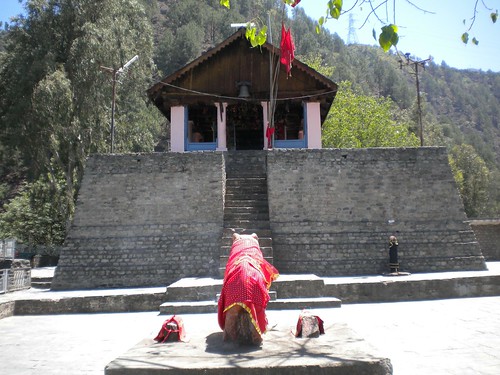Today, after 4 days of lazing, we tore ourselves away from Orchard Hut, bid adieu to the Dhami family and our Canadian friends, and took a cab to Khajjiar. En route, we decided to pay a visit to Chamba town. After all, having come so far, it would have been a little sad to leave without seeing this capital town of the district. Moreover, it fell on the way and Mr. Dhami briefed the cab driver on where to take us, so we didn’t have to bother about anything. According to him, only two out of the many temples in Chamba were worth visiting – the Chamunda Devi temple for its location and views of the valley, and the Laxmi Narayan temple complex for its architecture.
Bounded by the Pir Panjal range and the Dhauladhar range of mountains, the kingdom of Chamba is considered to be one of the oldest in North India. Its capital town has plenty of temples from the 10th to the 19th century commemorating its rich history. A large grassy lawn in its center, known as the Chaugan, was the center of all community activities back in the day. Today it has been divided into 5 sections and is used for everything from marriages to cricket. We simply passed by here in our taxi without stopping; the market road by it looked a little too chaotic!
Chamunda Devi temple is a simple, traditional temple that sits atop a hill adjacent to town.  From here the views out to river Ravi and the town of Chamba, are absolutely breathtaking! The temple itself is quite simple and traditionally built atop a tall, stone platform. Inside, the wooden beams that support the beautifully carved wooden ceiling also support many brass bells. Unfortunately, for us the inner sanctum was locked so we couldn’t take a look at the idol of the Devi. A rectangular, stone courtyard surrounds the platform and gives the temple complex a lovely, open feel; I enjoyed our brief visit here!
From here the views out to river Ravi and the town of Chamba, are absolutely breathtaking! The temple itself is quite simple and traditionally built atop a tall, stone platform. Inside, the wooden beams that support the beautifully carved wooden ceiling also support many brass bells. Unfortunately, for us the inner sanctum was locked so we couldn’t take a look at the idol of the Devi. A rectangular, stone courtyard surrounds the platform and gives the temple complex a lovely, open feel; I enjoyed our brief visit here!
Our next stop was the Laxmi Narayan temple complex, which is in the center of town amidst all  the shops and chaos. The complex consists of six temples and would have looked quite grand had they been enclosed within a large courtyard or landscaped area like the ones in Khajuraho. But here they are clustered within a small courtyard, which is surrounded by stores and narrow alleys on all sides. We were told that we shouldn’t leave our shoes unattended inside the temple complex as theft is common. So Madhu and I took turns visiting it. The main temple dedicated to Laxmi Narayan was right in front of the main entrance. The idol in its inner sanctum was tall and beautifully adorned in cloth and ornaments. This is the oldest shrine in the complex and dates back to the 10th century. The adjoining 5 temples are relatively newer. They are dedicated to Radha Krishna, Lord Vishnu and different forms of Lord Shiva. They were all quite gorgeous with wooden, carved shikharas and tiny inner sanctums. It’s a beautiful complex, no doubt, but its setting is not very inspiring; we left a little disappointed!
the shops and chaos. The complex consists of six temples and would have looked quite grand had they been enclosed within a large courtyard or landscaped area like the ones in Khajuraho. But here they are clustered within a small courtyard, which is surrounded by stores and narrow alleys on all sides. We were told that we shouldn’t leave our shoes unattended inside the temple complex as theft is common. So Madhu and I took turns visiting it. The main temple dedicated to Laxmi Narayan was right in front of the main entrance. The idol in its inner sanctum was tall and beautifully adorned in cloth and ornaments. This is the oldest shrine in the complex and dates back to the 10th century. The adjoining 5 temples are relatively newer. They are dedicated to Radha Krishna, Lord Vishnu and different forms of Lord Shiva. They were all quite gorgeous with wooden, carved shikharas and tiny inner sanctums. It’s a beautiful complex, no doubt, but its setting is not very inspiring; we left a little disappointed!
Chamba town has more temples and a couple of ruined palaces as well. But we didn’t bother visiting them all; we had already seen the most important ones of them. So we decided to head on towards Khajjiar, our destination of the day.


Am sorry, didnt notice part 2 of Himachal visit … nicely compiled info .. and beautiful pics .. all
Thanks a lot, Saurabh.
Cheers!